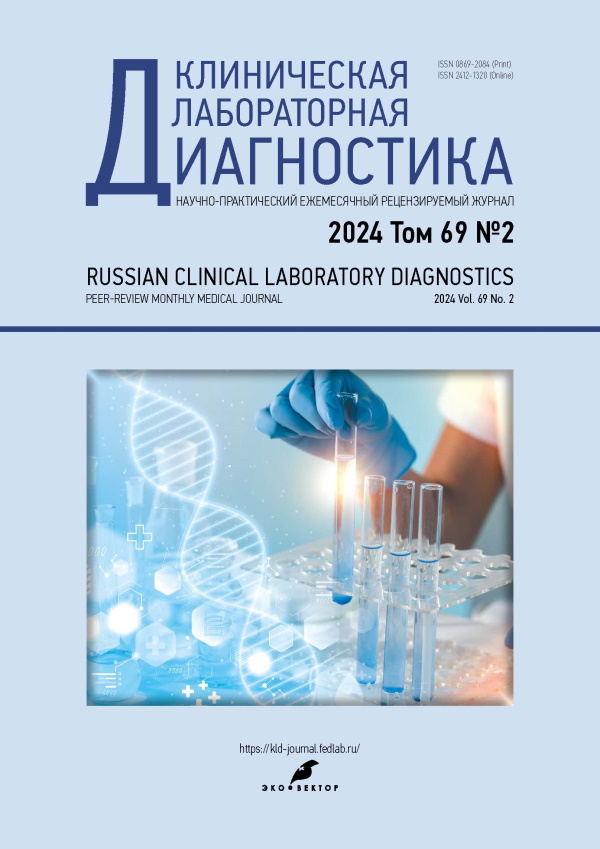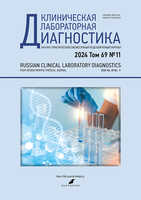Russian Clinical Laboratory Diagnostics
Peer-reviewed scientific and practical journal published monthly since 1955.
Editor-in-chief
- Tatiana V. Vavilova, MD, Dr. Sci. (Medicine), professor
ORCID iD: 0000-0001-8537-3639
Founders
- FEDERATION OF LABORATORY MEDICINE"
WEB: https://fedlab.ru/ - DIAGNOSTIC DEVELOPMENT CENTRE
WEB: https://anocrd.ru/
Publisher
- Eco-Vector
WEB: https://eco-vector.com/
About
“Russian Clinical Laboratory Diagnostics” (the old name is “Laboratornaia sluzhba”) is a monthly peer-reviewed scientific and practical medical journal published since 1955.
The journal publishes scientific original articles in various disciplines of laboratory medicine, descriptions of complex clinical diagnostic cases of diseases, information on scientific and practical events, discussions in the field of interests for laboratory practitioners.
Science fields of interest
Main sections
Call for Papers: Manuscript types
Publications
Indexation
|
Current Issue
Vol 69, No 11 (2024)
- Year: 2024
- Published: 25.07.2025
- Articles: 5
- URL: https://kld-journal.fedlab.ru/0869-2084/issue/view/13076
Original Study Articles
The Application of Multiplex Real-time PCR and Routine Culture Method in the Children Gut Microbiota Assessing
Abstract
Background: In recent decades, considerable attention has been paid to the study of the gut microbiota. Nevertheless, the existing diagnostic approaches to assessing the gut microbiota in clinical practice are very limited. In this regard, there is a need to introduce a validated laboratory method, taking into account modern ideas about the gut microbiota.
Aim: to compare the results of gut microbiota examination by a routine culture method and real-time PCR in children
Methods: 102 stool samples from children aged 0 to 14 years were simultaneously examined by a routine culture method and real-time PCR. The PCR was performed using the "Enteroflor Kiddy Kit" (DNA-Technology, Russia), which allows to determine the quantity of total bacterial mass, 40 groups of normal and opportunistic microorganisms, estimated numbers of "child" and "adult" bifidobacteria, the Clostridioides difficile enterotoxin genes – cdtA and cdtB, the Streptococcus agalactiae adhesin gene – Srr2, the staphylococcal marker of resistance to beta-lactam antibiotics – gene mecA, as well as the relative abundance of each bacterial group.
Results: The culture method allowed to isolate up to 15 microbial groups in the samples. The real-time PCR identified 43 groups, 2 virulence genes and one gene for antibiotic resistance in amounts up to 1011 GE/g, allowed to calculate the abundance of each target bacterial group from all detected bacteria. The best result matching between the culture method and the real-time PCR was noted for C. albicans (100% of double-negative results), Bifidobacterium spp. (92.2% matches), E. coli (80.4% matches) and S. aureus (64.7% matches). Whereas for the other compared microbial groups, the matching results were recorded only in 9.8-36.3% of the samples. The greatest discrepancies concerned difficult-to-cultivate groups of microorganisms, such as lactobacilli, clostridia, and bacteroids.
Conclusion: The real-time PCR method was able to confirm the positive results of the culture study in 94.3% of cases, whereas the growth of microorganisms in PCR-positive samples was noted only in 32% of cases. The spectrum of microbial markers determined by real-time PCR significantly exceeded that for the culture method.
 325-335
325-335


Antimicrobial activity of silver proteinate and its changes during storage
Abstract
Background: In the context of the growing problem of antibiotic resistance, the selection of drugs with non-specific antimicrobial action is a relevant approach for treating upper respiratory tract infections. Silver protein, known for its antimicrobial properties, is used as an active ingredient in several medical formulations.
Aim: The work aimed to assess the effect of storage duration and temperature on the antimicrobial activity of the pharmaceutical preparation with the International Nonproprietary Name silver protein.
Methods: To conduct the experimental study, reference strains of Staphylococcus aureus (ATCC 6538), Escherichia coli (ATCC 25922), Pseudomonas aeruginosa (ATCC 9027), Bacillus cereus (ATCC 14579), and Candida albicans (ATCC 10231) were used as test cultures, along with silver protein solutions stored at 22 °C and 7 °C. Inoculations were performed from day 0 to day 75 at 7-day intervals. Antimicrobial efficacy was assessed by comparing the diameters (mm) of microbial growth inhibition zones throughout the experiment.
Results: On day 30, the diameters of the inhibition zones were larger in the 7 °C group: S. aureus by 25.0% (p = 0.033), E. coli by 12.2% (p = 0.041), P. aeruginosa by 18.3% (p = 0.042), B. cereus by 10.0% (p = 0.005), and C. albicans by 42.7% (p = 0.016). On days 37, 45, 53, 60, 68, and 75 of the study, the diameters of the inhibition zones for S. aureus, P. aeruginosa, B. cereus, and C. albicans remained unchanged (9, 8, 7, and 7 mm, respectively); for E. coli, on days 37, 45, 53, and 60, the diameters remained the same as on day 30 (8 mm), whereas on days 68 and 75 a decrease to 7 mm was observed (12.5%, p = 0.005).
Conclusion: Keeping the solution at 7 °C for 30 days does not reduce its antimicrobial activity, making it possible to choose a convenient storage option for the working solution. Given the preservation of antimicrobial activity through day 75, silver protein can be recommended for treating superinfections and chronic forms of rhinosinusitis.
 336-342
336-342


Opportunities for assessing ex vivo neutrophil extracellular trap formation and blood citrullinated histone h3 levels in risk evaluation and stratification in children with residual post-tuberculosis pulmonary changes
Abstract
Background: Residual pulmonary changes may develop in children after tuberculosis treatment, contributing to the risk of disease recurrence. This highlights the relevance of non-invasive laboratory diagnostic approaches for risk assessment and stratification.
Aim: The work aimed to assess the ex vivo ability of neutrophil leukocytes isolated from blood to form neutrophil extracellular traps in response to nonspecific antigenic stimulation in children with post-tuberculosis pulmonary changes, in relation to the in vivo level of citrullinated histone H3 (citH3) in blood.
Methods: The study groups included a control group of healthy children aged 4 to 7 years (n = 26) and a group of children with residual post-tuberculosis changes (Post-TB) aged 4 to 14 years (n = 18). Eligibility criteria: absence of concomitant chronic somatic, infectious, or autoimmune diseases. Neutrophils isolated from peripheral blood were stimulated with a polybacterial agent. Neutrophil extracellular traps formation was assessed using fluorescence microscopy. The level of citrullinated histone H3 was measured using enzyme-linked immunosorbent assay. Differences between groups were considered significant at p < 0.05 and evaluated using the Mann–Whitney and Kruskal–Wallis tests, followed by post-hoc analysis. The Post-TB group was divided into subgroups with low (Post-TB-L) and high (Post-TB-H) neutrophil extracellular traps formation capacity.
Results: In the Post-TB group, the proportion of thread-like extracellular traps and the total proportion of extracellular traps were significantly higher than in the control group (p = 0.0016 and p = 0.0035, respectively). The concentration of citrullinated histone H3 in the Post-TB group was also higher than in the control group (p = 0.0101). No differences were observed between the groups in terms of cloud-like neutrophil extracellular traps (p = 0.8047). In the Post-TB-H subgroup, the proportion of thread-like extracellular traps and total extracellular traps was higher than in the control group (ppost-hoc = 0.00002 and ppost-hoc < 0.0001, respectively). In the Post-TB-L subgroup, the proportion of thread-like neutrophil extracellular traps was lower than in the Post-TB-H subgroup (ppost-hoc = 0.0021). Blood citrullinated histone H3 levels in the Post-TB-H subgroup were higher than in the control group (ppost-hoc = 0.0105) and the Post-TB-L subgroup (ppost-hoc = 0.0292). Spearman’s correlation coefficient between the proportion of thread-like extracellular traps and blood citrullinated histone H3 concentration was r = 0.711 (p = 0.0006).
Conclusion: Neutrophil ability to form neutrophil extracellular traps in children with post-tuberculosis pulmonary changes shows distinct features. Research in this area may prove useful for personalized risk assessment of tuberculosis recurrence.
 343-356
343-356


Reviews
Method for assessing the immunogenicity of blood group antigens and clinical significance of erythrocyte antibodies
Abstract
The clinical significance of blood group antigens is determined by their ability to stimulate the formation of alloantibodies in response to red blood cell transfusions. The frequency of antibody detection in recipients exhibits country-specific characteristics and depends on the antigenic diversity of the population, the use of anti-Rh immunoglobulin, and the implementation of alloimmunization prevention strategies in transfusion therapy. The effects of antibodies in transfusions involving incompatible erythrocytes range widely—from mild symptomatic anemia to life-threatening complications.
The conducted analysis of large-scale immunohematological studies allowed for the classification of antigens into highly immunogenic—D, E, K (Kell); moderately immunogenic—C, c, Jka (Kidd), Fya (Duffy), M (MNS), Lea (Lewis); and low-immunogenic—other erythrocyte antigens. Analysis of annual SHOT (Serious Hazards of Transfusion, UK) and FDA (Food and Drug Administration, USA) reports showed that monospecific antibodies to Jka, Jkb, Fya, c, and E antigens account for the majority of delayed hemolytic reactions, whereas antibodies to K, Fya, c, Jka, and Jkb antigens are responsible for most transfusion-related fatalities.
A review of studies on the immunological safety of erythrocyte transfusions led to the development of a method for quantitatively assessing the immunogenicity of antigens and the clinical significance of monospecific antibodies. Each erythrocyte antigen was assigned a numerical value expressed in arbitrary units. This antigen significance factor can be used in phenotypic donor matching—including via software—and in selecting erythrocytes with the lowest clinical risk of alloimmunization and transfusion complications in critical situations when blood components fully matched to the recipient’s phenotype are unavailable.
 357-364
357-364


Screening for iron deficiency conditions as an effective tool for donor blood management
Abstract
Regular blood donation may lead to the depletion of iron stores in donors, which affects their health and impacts the quality of collected blood components. This review highlights the relevance of monitoring iron metabolism in donor practice and its role in blood donor management systems.
A scientific data search was conducted from February to October 2024 using the following electronic databases: PubMed, Scopus, Web of Science, eLIBRARY.RU, and Google Scholar. The analysis included original research articles, systematic reviews, meta-analyses, and clinical guidelines.
Modern approaches to donor potential management should include screening of iron metabolism indicators, personalized donation interval planning, and timely prevention of iron deficiency conditions. The implementation of iron status monitoring programs ensures donor safety, optimizes donation frequency, and helps maintain stable supplies of blood components of appropriate quality.
The authors place particular emphasis on the cost-effectiveness of preventive measures compared to the treatment of developed iron deficiency, which is crucial for the rational use of blood service resources.
 365-375
365-375












